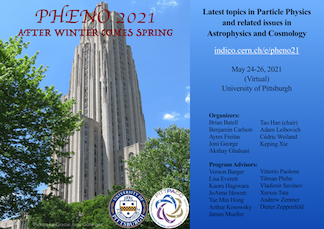Speaker
Description
[This is based on Phys.Rev. D100 (2019) no.3, 035009 by Soumita Pramanick]
In this model, realistic neutrino mixing is obtained radiatively using $S_3 \times Z_2$
symmetry at one-loop level. The two right-handed neutrinos present in the model when maximally mixed
can yield the structure of the left-handed Majorana neutrino mass matrix corresponding to
$\theta_{13}=0$, $\theta_{23}=\pi/4$ and any value of $\theta_{12}^0$ specific to the Tribimaximal (TBM), Bimaximal (BM) and Golden Ratio (GR) or some other mixings.
Non-zero $\theta_{13}$, deviation of $\theta_{23}$ from $\pi/4$ and
small corrections to the solar mixing angle $\theta_{12}$ can be achieved in a single stroke by shifting from this maximal mixing in the right-handed neutrino sector by a small amount.
In this scotogenic model where non-zero $\theta_{13}$ was obtained by deviating from maximal mixing in the right-handed neutrino sector, two $Z_2$ odd inert $SU(2)_L$ doublet scalars were also present, the lightest of which can be a dark matter candidate.
Summary
In this model, realistic neutrino mixing is obtained radiatively using $S_3 \times Z_2$
symmetry at one-loop level. The two right-handed neutrinos present in the model when maximally mixed
can yield the structure of the left-handed Majorana neutrino mass matrix corresponding to
$\theta_{13}=0$, $\theta_{23}=\pi/4$ and any value of $\theta_{12}^0$ specific to the Tribimaximal (TBM), Bimaximal (BM) and Golden Ratio (GR) or some other mixings.
Non-zero $\theta_{13}$, deviation of $\theta_{23}$ from $\pi/4$ and
small corrections to the solar mixing angle $\theta_{12}$ can be achieved in a single stroke by shifting from this maximal mixing in the right-handed neutrino sector by a small amount.
In this scotogenic model where non-zero $\theta_{13}$ was obtained by deviating from maximal mixing in the right-handed neutrino sector, two $Z_2$ odd inert $SU(2)_L$ doublet scalars were also present, the lightest of which can be a dark matter candidate.
